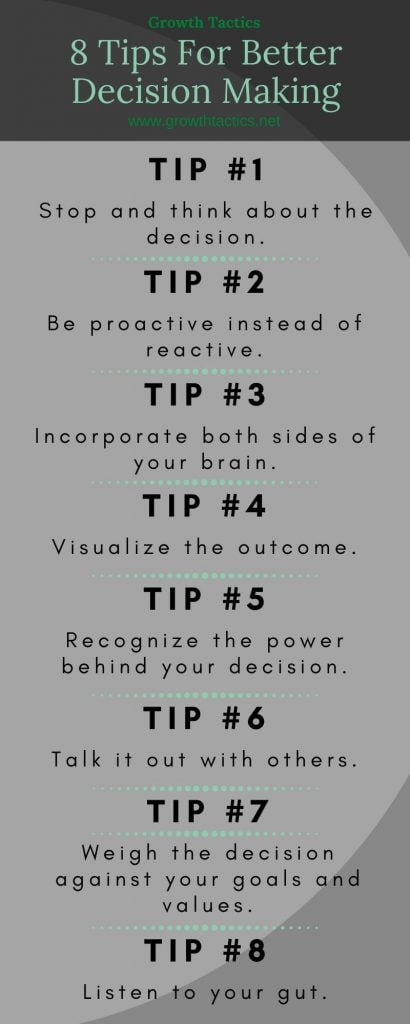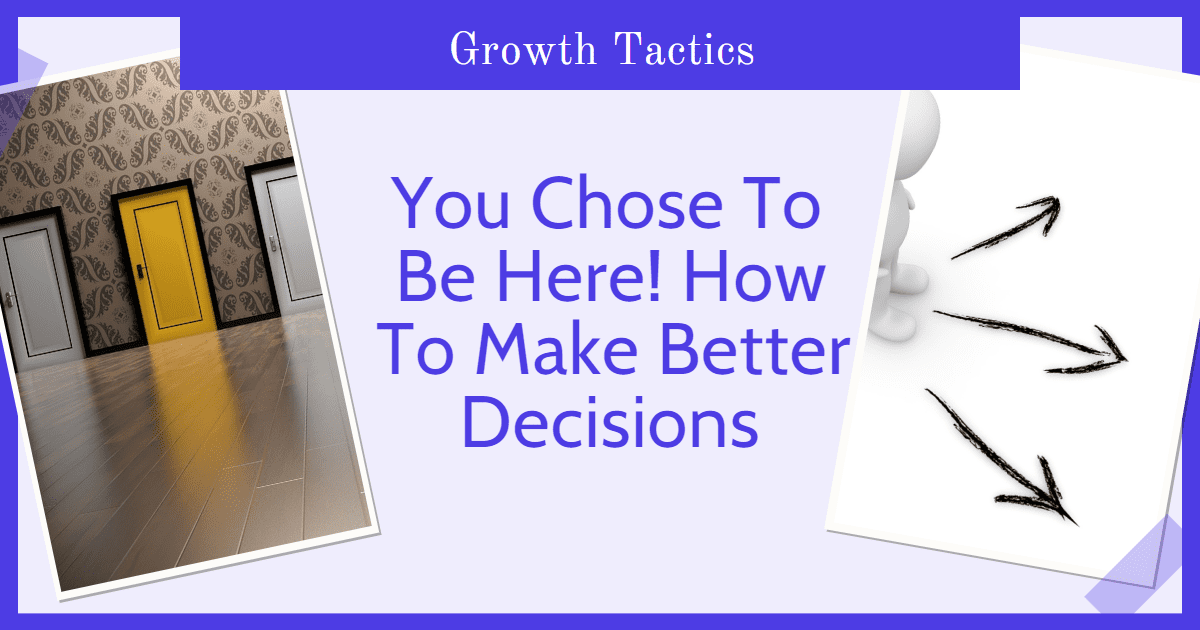Last Updated on August 26, 2023 by Milton Campbell
I know what you’re saying “My decisions have nothing to do with the predicament I’m in.” “I didn’t choose to be broke.” “Getting laid off wasn’t my choice.” “Having a boss that I can’t stand wasn’t my choice.” “I didn’t choose to have all these problems in my life.” The fact of the matter is that almost anything that happens in our lives boils down to a decision we made.
You can learn how to make better decisions.
Too often we get stuck in the mindset of blaming others for the circumstances we are in. It’s not your job’s fault for not paying you enough. You decided to take that job. You decided not to find ways to make additional money. Or you decided not to go find a new job. We can say this for almost any problem in our lives.
Once we stop being the victim and start taking ownership of our problems, we can start coming up with solutions.

Tips for Common Problems
You have financial troubles

There are only three ways you can have more money. You can either spend less, bring in more, or do both.
Spend less money – The first step is to realize where your money goes. Many great apps can track your finances for you. See this link for a list of personal finance apps. After you know where your money is going, make a list of needs and wants. Be honest with yourself. Things like cable tv and lattes are in the wants category. Start cutting back on some of the items in your wants category. Also, take a look at things in your needs category and see if those can be minimized. For example, you may be able to lower costs for things like car insurance by shopping around.
Bring in more money – There are so many ways to make money. It all depends on whether you are willing to go out and get it. You can get a second job. Or you can sell some of the items you don’t use anymore on eBay or Facebook Marketplace. You can start a side hustle. Side hustles can be anything from driving for Uber to doing side jobs on Upwork. Side hustles are a great way to bring in more money and many times can be more lucrative than your full-time job. See this article for more side hustle ideas.
You hate your job

If you can’t stand your job you have a couple of options. You can either get a new job or you can make the circumstances better within your current job.
Get a new job – First thing you want to do is get your resume in order. There are many great resources available to help you build a professional-looking resume. After your resume is in order, you can begin looking for a new job. Many employers use websites like Indeed and LinkedIn to find new talent. These are great places to start.
Make current job better – Believe it or not, just because your job stinks it doesn’t mean you can’t make it better. You have the power to lead the change and not only make it better for yourself but for others as well. See my previous post about tips to deal with a toxic workplace.
You are unhealthy
Getting healthy involves both eating right and exercising.
Eating right – Eating a well-balanced diet and cutting out things that aren’t good for you not only improves how you look but also improves how you feel physically and mentally. If you are on the heavier side, improving your diet is the most important thing you can do to lose weight. See this website for great tips on weight loss.
Exercising – 30 minutes of exercise 5 days a week is recommended but you don’t have to start there. If you are out of shape you can start with something easy like parking further away when you go to the store and building up from there. You don’t have to go out and run a marathon, but exercise needs to become a part of your lifestyle.
A relationship ended

The end of relationships can be one of the tougher things we have to face in our lives but it’s not the end of the world. Everyone has heard the saying “Time heals all wounds.” It may not feel like while you’re going through it but as time goes on the pain becomes less and less. Family and friends are also great at helping us through these situations. Don’t push them away, they want to be there for you, and you need them.
You made a mistake
Everyone messes up. The best thing to do is to own it and learn from it. Life’s most memorable lessons come from mistakes. See my article about dealing with mistakes for more tips.
One of your possessions broke or got messed up
Did your tv fall off the wall and break or did someone hit your car and it got totaled? Sometimes these things happen in life. We can always get new possessions. There is no point in getting mad or getting yourself worked up. Save your energy for things you can control. The important thing is that you’re ok.
You feel like your life has no meaning
One of the best things you can do when you feel this way is to go out and experiment with different things that help others. You can go out and volunteer at your local soup kitchen. You can volunteer at your local animal shelter. Or you can volunteer at an organization like habitat for humanity. Keep trying out new things until you find your cause, your purpose, and your mission.
You are stressed out
Being too stressed out can affect a lot of areas of your life. Your health, productivity, and mood can suffer due to stress. When you feel yourself getting stressed, ask yourself “Is this something within my control?” If it’s out of your control, then it’s not worth getting stressed out about. Sometimes that is easier said than done. If you still find yourself stressed out do something to take your mind off it. Go exercise, go for a walk, read a book, or do anything else that takes your mind off it, and makes you a better person simultaneously.
You don’t have enough time

This is one of the biggest excuses that we tell ourselves and others. We don’t have enough time to go work out, hang out with our kids, or do any other thing we know is good for us and our loved ones. We are busy people but somehow, we find the time to watch tv for hours or play games on our mobile devices. Much like finances you can make a list of needs and wants when it comes to your time. Look for areas where you are wasting your precious time and replace that with something that will make you better as a person.
Additional Tips for Making Better Decisions
The best way to fix issues is to avoid them, to begin with. Although we can’t avoid all our problems, we can certainly minimize them by making better decisions in the first place.
Stop and think about the decision
In today’s fast-paced world, it’s easy to feel pressure to make quick decisions. However, taking a moment to process a decision before committing can lead to better outcomes. This doesn’t mean you should get stuck in analysis paralysis, but rather take a few minutes to assess the situation and perform a mini risk management exercise.
Risk management is all about evaluating the potential upsides and downsides of each option. By consciously weighing these factors, you can make more informed choices that align with your goals and values. Many times, we rely on our instincts or emotions to guide our decisions without considering the possible consequences.
To effectively process a decision, follow these steps:
- Identify the options: List out the available choices, including any alternative solutions that may not be immediately apparent.
- Evaluate the pros and cons: For each option, consider the potential benefits and drawbacks. This helps you to understand the risks and rewards associated with each choice.
- Consider the impact: Think about how your decision will affect not only yourself but also other people and aspects of your life. Take into account both short-term and long-term consequences.
- Prioritize your values: Reflect on what is most important to you and determine which options best align with your personal values and priorities.
- Make a decision: After analyzing the options, choose the one that best meets your needs and goals. Remember, no decision is perfect, and you may need to be flexible and adapt as circumstances change.
By taking a moment to process your decisions, you can make more thoughtful choices that lead to better outcomes, reduce the likelihood of regrets, and ultimately contribute to a more fulfilling life.
Be proactive instead of reactive
Proactive decision-making and problem-solving are crucial skills for navigating life’s challenges effectively. By anticipating potential issues or decisions before they arise, you can create a plan of action, reduce stress, and ultimately make better choices. Here are some strategies to help you foresee and prepare for future decisions and problems:
- Develop situational awareness: Cultivate the habit of observing your environment, relationships, and circumstances to identify patterns, trends, and potential challenges. This awareness enables you to spot early warning signs of upcoming decisions or problems and take preventive measures.
- Reflect on past experiences: Analyze your previous encounters with similar situations or decisions. Identify what went well, what could have been improved, and how you can apply those lessons to future scenarios.
- Set clear goals and priorities: Having a clear vision of your personal and professional objectives helps you stay focused on what’s important. This clarity enables you to make decisions that align with your goals and anticipate potential obstacles or choices you may face along the way.
- Conduct scenario planning: Imagine different scenarios that could arise in the future, and consider how you would respond to each situation. By exploring various possibilities, you can develop strategies and contingency plans that prepare you for a range of outcomes.
- Seek input and advice: Consult with trusted friends, family members, or mentors who can offer valuable insights and perspectives on potential problems or decisions. Their experiences and knowledge can help you identify blind spots and make more informed choices.
- Practice mindfulness: Engage in mindfulness exercises, such as meditation or journaling, to improve your focus, self-awareness, and emotional regulation. These practices can enhance your ability to anticipate and respond to future challenges with greater clarity and resilience.
By adopting these proactive strategies, you can stay ahead of the curve and avoid being caught off-guard by unexpected decisions or problems. Over time, this forward-thinking approach will help you become more adaptable, prepared, and confident in facing life’s uncertainties.
Incorporate both sides of your brain
The left side of your brain controls logic and reason. The right side controls emotion. It’s important to allow a good balance between emotion and logic when making decisions. Leaning too far to one side or the other can inhibit your ability to make a good decision.
To achieve the optimal balance between emotion and logic, it’s essential to recognize the value of both and integrate them into our decision-making process. Here are some tips to help you strike the right balance:
- Assess your natural tendencies: Reflect on your past decisions and evaluate whether you tend to lean more toward logic or emotion. Recognizing your default approach will help you identify areas for improvement.
- Gather information and listen to your instincts: When making decisions, gather all relevant data and analyze it. Simultaneously, pay attention to your gut feelings and emotional responses. Combine these two sources of information to arrive at a well-rounded decision.
- Seek diverse perspectives: Engage with others who possess different thinking styles than your own. By considering diverse viewpoints, you can gain a more comprehensive understanding of a situation and make more balanced decisions.
In conclusion, effective decision-making involves a delicate interplay between the rational left hemisphere and the emotional right hemisphere of our brain. By consciously nurturing a harmonious relationship between these two forces, we can make better choices that not only align with our values and feelings but are also backed by solid reasoning and analysis.
Visualize the outcome
Taking a moment to close your eyes and visualize the possible outcomes of your decisions can be a powerful tool for personal and professional development. By engaging in this mental exercise, you can gain valuable insights into the potential consequences of your choices, allowing you to make more informed decisions moving forward.
When you engage in visualization, you’re able to tap into your intuition and emotions, which can provide a different perspective on the situation. This is especially important when logic and reason alone may not give you a complete picture of what lies ahead. By envisioning how each decision may feel and what obstacles may arise, you’re better equipped to choose a path that aligns with your goals and values.
To maximize the effectiveness of this technique, it’s essential to consider all options related to a particular decision. This means exploring not only the most obvious choices but also the less apparent alternatives. By giving equal consideration to each possibility, you can ensure that you’re making a well-rounded and informed decision.
To further enhance your visualization practice, consider incorporating the following elements:
- Embrace mindfulness: Find a quiet space where you can be present and free from distractions. Focus on your breath and let go of any preconceived notions about the situation at hand.
- Be specific: When visualizing each outcome, try to be as detailed as possible. Think about the sights, sounds, and emotions associated with each scenario, and consider how each choice aligns with your long-term goals.
- Engage your senses: To make your visualization more vivid and immersive, engage all your senses. Imagine the sounds, smells, tastes, and tactile sensations that accompany each outcome.
- Consider timeframes: Think about the short-term and long-term implications of each decision. Some choices may yield immediate benefits but have long-term drawbacks, while others may require patience and perseverance but ultimately lead to greater rewards.
- Reflect and evaluate: After visualizing each potential outcome, take a moment to reflect on what you’ve experienced. Weigh the pros and cons of each option, and consider how they align with your values and objectives.
By incorporating visualization into your decision-making process, you can gain a deeper understanding of the potential outcomes and challenges associated with each choice. This, in turn, can help you make more thoughtful and informed decisions, ultimately leading to greater success and fulfillment in all areas of your life.
Recognize the power behind your decision
Recognizing the weight and significance of our decisions is crucial for making responsible choices that benefit ourselves and those around us. Each decision we make has the potential to create a ripple effect, impacting not only our lives but also the lives of others. By being mindful of these potential consequences, we can make more informed and considerate choices.
Here are some ways to help you understand and appreciate the weight behind your decisions:
- Consider the stakeholders: Identify the people who might be affected by your decision, both directly and indirectly. This may include family members, friends, colleagues, or even entire communities. Acknowledge their needs, feelings, and perspectives as you weigh your options.
- Reflect on your values: Align your decisions with your personal values and beliefs. This will ensure your choices are not only beneficial to you but also ethically sound and considerate of others.
- Assess potential consequences: Analyze both the positive and negative repercussions of each decision. Consider the short-term and long-term impacts, and think about how they might influence various aspects of your life and the lives of others.
- Seek feedback: Consult with others who have experience or expertise related to your decision. Their insights and perspectives can help you better understand the potential consequences of your choices and make more informed decisions.
- Practice empathy: Put yourself in the shoes of those who may be affected by your decision. Consider how they might feel and what their needs and preferences might be. By practicing empathy, you can make decisions that are more compassionate and considerate of others.
- Learn from past experiences: Reflect on the outcomes of previous decisions you’ve made, and think about what you can learn from those experiences. By doing so, you can develop a better understanding of the weight and implications of your choices moving forward.
- Be prepared to adapt: Understand that decisions are rarely set in stone and can often be adjusted or revised as new information becomes available. Remain open to changing your course of action if it becomes clear that doing so would be beneficial to yourself and others.
By fully realizing the weight behind your decisions and considering the potential effects on those around you, you can make more responsible, thoughtful, and compassionate choices. This mindful approach to decision-making will lead to greater personal fulfillment and promote stronger relationships with others.
Talk it out with others
Seeking the advice and opinions of others can be an invaluable tool in the decision-making process. Each individual possesses unique experiences, knowledge, and perspectives that can shed light on aspects of a situation that we might not have considered. By engaging in open and honest conversations with trusted confidants, we can expand our understanding of a situation and potentially uncover new options or solutions.
Here are some ways to effectively seek advice from others and make the most of their insights:
- Choose the right person: When seeking advice, look for someone who has relevant experience, knowledge, or expertise in the matter at hand. This could be a friend, family member, colleague, or mentor. Ensure that the person you approach is someone you trust and who has your best interests at heart.
- Be open and honest: When discussing your situation, be transparent about your thoughts, feelings, and concerns. This will allow the person you’re seeking advice from to gain a clear understanding of your situation and provide more accurate and helpful guidance.
- Ask open-ended questions: Encourage thoughtful discussions by asking open-ended questions that allow for elaboration and exploration. This can help you and the person you’re seeking advice from delve deeper into the issue and uncover new perspectives.
- Listen actively: Pay close attention to the advice being offered, and actively engage in the conversation by asking follow-up questions or seeking clarification when needed. Make sure to listen without judgment and be open to ideas that may challenge your preconceived notions.
- Evaluate the advice: Remember that the advice offered is just one perspective, and it’s ultimately up to you to decide whether or not it’s applicable to your situation. Consider the advice in the context of your own experiences, values, and goals, and weigh the pros and cons before making a decision.
- Express gratitude: Regardless of whether you choose to follow the advice given, always thank the person for their time and insights. Showing appreciation for their assistance helps maintain strong relationships and ensures they’ll be willing to help you again in the future.
- Reflect and apply: Take some time to reflect on the advice received and consider how it can be incorporated into your decision-making process. Even if you don’t follow the advice directly, it may have opened your eyes to new possibilities, allowing you to make a more informed decision.
By seeking the advice of others and being open to their perspectives, you can gain valuable insights and broaden your understanding of a situation. This collaborative approach to decision-making can lead to more thoughtful choices and better outcomes for everyone involved.
Weigh the decision against your goals and values
The Importance of Aligning Decisions with Personal Goals and Values: A Two-Question Approach
In the fast-paced world, we live in, it’s easy to get caught up in the whirlwind of making decisions that may not always align with our true selves. It’s important to take a step back and ensure that our choices support our personal goals and values. By adhering to a simple two-question approach, you can ensure that your decisions are consistent with the person you want to be and the life you want to live.
- Does this decision support my goals?
Before making a decision, it’s crucial to evaluate how it aligns with your personal goals. Whether you’re striving for career advancement, financial stability, or personal development, every choice you make should ideally propel you forward in the direction you’ve set for yourself.
By consistently asking yourself if a decision supports your goals, you’ll be more likely to make choices that contribute to your long-term success. This doesn’t mean that every decision will be perfect or without challenges, but it will help you stay focused on the bigger picture and maintain your momentum toward your objectives.
- Does this decision fit in with my values?
In addition to considering your goals, it’s important to reflect on how a decision fits in with your values. Your values are the guiding principles that shape your life and influence your actions. When making choices, it’s essential to stay true to these core beliefs and ensure that your decisions align with them.
If a decision goes against your values, it may lead to feelings of dissatisfaction, regret, and internal conflict. By asking yourself if a choice fits in with your values, you’ll be more likely to make decisions that are authentic and resonate with your true self.
Putting it all together
By consistently evaluating decisions based on these two questions, you’ll create a strong foundation for a life that is both fulfilling and aligned with your true self. It’s important to remember that this process is not about perfection, but rather about developing a habit of mindful decision-making that will help you navigate life with greater clarity and purpose.
Listen to your gut
Intuition, or gut feelings, can be a powerful tool in decision-making. These feelings often arise from our subconscious, based on past experiences and patterns that we might not be consciously aware of. However, relying solely on intuition without considering the facts and rational aspects of a situation can lead to impulsive and potentially regrettable decisions. It’s important to strike a balance between trusting your instincts and engaging in a thoughtful decision-making process.
Here are some steps to help you effectively incorporate intuition into your decision-making:
- Acknowledge your gut feeling: Recognize when you have a strong instinct about a situation or decision. Be open to the possibility that your intuition could be providing valuable insight, even if it’s not immediately obvious.
- Analyze the situation: Before making a decision based solely on your gut feeling, take the time to gather all the relevant information and analyze the situation objectively. Consider the facts, weigh the pros and cons, and assess potential outcomes.
- Reflect on past experiences: Your gut feelings may be influenced by previous experiences, both positive and negative. Reflect on similar situations you’ve encountered in the past and consider whether your intuition was accurate or led you astray. This can help you determine the reliability of your instincts in the current situation.
- Identify the source of your intuition: Try to pinpoint the reason behind your gut feeling. Are there specific factors or patterns that trigger your instincts? Understanding the source of your intuition can help you determine its validity and relevance to the decision at hand.
- Balance intuition with rational thought: Use your intuition as one component of your decision-making process rather than the sole determining factor. Consider your gut feeling alongside objective data and rational analysis to make a well-rounded, informed decision.
- Trust your judgment: Once you’ve taken the time to analyze the situation, reflect on past experiences, and consult with others, trust yourself to make the best decision possible. Don’t second-guess yourself or let fear of making the wrong decision paralyze you. Remember that you can always learn from your choices and adapt as needed.
By incorporating intuition into your decision-making process, you can benefit from the wisdom and insight that your gut feelings provide while also ensuring that your choices are grounded in rational thought and objective analysis. This balanced approach will lead to more thoughtful decisions and ultimately, greater personal and professional success.
Wrapping it All Up
Making better decisions can put you in a better position in the future. Blaming others for the spot you are in does nothing except distract you from doing the things you need to do to fix the situation. No matter what situation you are in, take responsibility. The situation may not be your fault but if you want it to change, it’s your responsibility to change it.
Did you enjoy this article on how to make better decisions? Please share and subscribe below.


